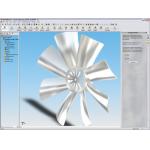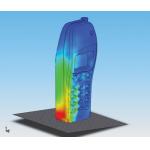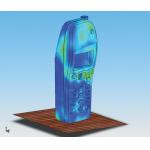Latest News
June 1, 2005
By Louise Elliott
In its 2006 release, COSMOSWorks has added a number of intelligent tools to help design engineers increase the scope of design validation analyses they can perform reliably and confidently. Built around the theme of “Design Analysis Made Simple,” the new release also has a number of advanced analysis features, including several packaged in easy-to-use, nonintrusive wizards.
For example, an interactive wizard, called Analysis Advisor, answers many basic analysis questions, and can walk new or occasional users through such problems as the kind of analysis to perform, what to do if a part or assembly fails to mesh, and how to interpret analysis results (see Figure below).
|
|
| Figure 1: The Analysis Advisor in COSMOSWorks 2006 guides the designer through problems step-by-step. Click on image to enlarge. |
“The Analysis Advisor offers a compendium of best practices that educate new users while they work,” says Ramesh Ramalingam, COSMOS product manager. “For instance, if the user wants to know about the factor of safety built into a part or assembly, he first needs to know if a material is ductile or brittle. If he doesn’t have that information, the Analysis Advisor will ask the right questions and offer tips to help him make his decisions.”
New, intelligent types of loads and supports—similar to the virtual connectors introduced in COSMOSWorks 2005—have been added to the software. Specifically, the supports are spot welds, ground bolts, and links; the loads, or boundary conditions, consist of virtual walls and hinges.
The software prompts the user through processes that used to take dedicated analysts a long time, making very complicated analyses much easier to perform. In essence, the virtual connectors, loads, and supports have the equivalent of what would be very time-consuming manual work already programmed into them.
In a new Analysis Library feature, novice users—and experts mentoring them—can create sets of loads and restraints that can be dragged from one part or assembly to another, adding automation to repetitious types of analyses, especially those specific to individual companies.
Making Tough Problems Simpler
Meshing has always been a struggle for new users of design analysis. COSMOSWorks 2006 contains many enhancements to make the meshing process transparent to the user, while enabling more precise analysis. The program now makes it possible to analyze assemblies of thick and thin components by using a combination of solid mesh for thick bodies, and shells for thin bodies (see Figures below). The mixed meshing enables accurate analysis of thick and thin components with fewer resources.
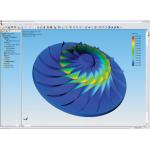
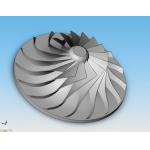
COSMOSWorks2006 users can analyze assemblies of thick and thin components using a combination of solids and shells. Click on images to enlarge.
The addition of h-adaptive meshing enables the program to converge automatically to a correct solution. The mesh automatically iterates refinements of critical areas until the solution converges. This relieves users of much of the guesswork and frustration of refining the mesh manually.
Moreover, the software now offers an improved user interface for surface-to-surface contact meshing, as well as the ability to analyze multi-body parts, and define contact conditions between the multiple bodies.
“COSMOSWorks users can now also use bonding elements to mesh two parts separated by an area of clearance without changing the model,” adds Ramalingam.
Drop Test and Fatigue Analysis Improvements
The new release features enhancements to COSMOSWorks’ drop tests that enable users to perform drop tests on assemblies, so that they can study the interaction of different components, as well as the effects of shifting and damage (see Figure below). Users can now also specify a flexible floor so that they can study the different effects of dropping the object on a concrete floor or a carpeted floor. They can also measure velocity and acceleration after impact—an important tool for designing electronics equipment.
|
|
| A |
|
|
| B |
Difference in stress distribution when a cell phone dropped from the same height on a rigid floor (A) and a flexible, wooden (B) floor. Click on images to enlarge.
COSMOSWorks’ fatigue analysis has been enhanced to include assemblies where each part has a different S-N curve—a time saver for users. It can also now plot rainflow and damage matrix plots at any location.
The module supports load history data, so that loads of varying amplitude can be studied. Ramalingam points out an example, saying, “In real life, a car going down a road encounters a number of surfaces, and develops a varying load history. By being able to account for those variations, the software can now predict how many trips the vehicle can make before a part failure.”
Optimization, PDM, and More
Also new for 2006, the software uses Design of Experiments (DOE) technology to help users find optimum design solutions. COSMOSWorks makes the process of shape optimization easier as well, by using a property manager rather than dialog boxes for such optimization input as objectives, design variables, and constraints.
For the first time, PDMWorks supports results of COSMOSWorks analyses. Designers can check these files in and out of the vault, and archive results of analyses for multiple design revisions.
Another new tool draws on capabilities in SolidWorks, offering a “What’s Wrong?” infrastructure that provides visual indication of whether the loads, restraints, mesh, and results are valid. The “What’s Wrong?” feature flags all changes in the feature tree, so that the designer can find and check results that may have become incorrect due to design changes.
COSMOSWorks 2006 also makes it possible for users to search COSMOS Knowledge Base articles from within the SolidWorks interface, along with search materials on Matweb.com.
A number of new capabilities have also been added to COSMOSMotion and COSMOSFloWorks—and information about those and additional capabilities can be found at the COSMOS website.
Overall, the new release makes design validation easier and faster for novice and advanced users alike.
Contributing editor Louise Elliott is a freelance writer based in California. Offer Louise your feedback on this article through e-mail c/o DE‘s Editors.
Product Information
COSMOSWorks 2006
SolidWorks Corp., SRAC Division
Los Angeles, CA
Subscribe to our FREE magazine, FREE email newsletters or both!
Latest News
About the Author
DE’s editors contribute news and new product announcements to Digital Engineering.
Press releases may be sent to them via [email protected].







